The Dark Summer is the latest title in designer Ted Racier’s “Dark” World War II series of wargames. The Dark Valley (2013) was the first in the series and covered the war on the Eastern Front. This was followed by The Dark Sands (2018) and The Deadly Woods (2021) on the war in North Africa and the Battle of the Bulge, respectively. This latest installment published in 2021 recreates the D-Day landings and campaign in Normandy, France. So how does it compare with other Normandy games, and should you own a copy?
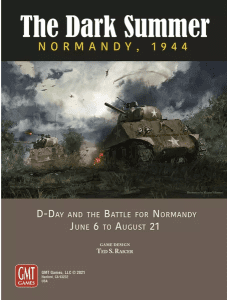
The “Dark” Chit Pull System
What all games in the series share is Ted’s innovative chit-pull system that simulates the fog of war and the differences in the operational tempo of the combatants. Using random chit pulls – blindly selecting a counter out of a cup – is certainly not new. Typically, it is used to activate specific formations (regiments, brigades, divisions, corps, etc.) on the board. The activation chits for both combatants are put in a single cup at the start of a turn. Chits are pulled from the cup, so rather than one side activating (i.e., moving and attacking) with all their units, followed by the other side doing the same, units are activated in a random sequence throughout the turn. This approach means that it’s possible one player may be able to activate several formations in a row while the other player sits idle, helping create the fog of war, as well as simulating sustained offensives.
What Ted’s system does is include different types of chits that can be pulled. For example, in The Dark Valley, there are not only chits for activating specific formations, but also chits for activating several, and even all, of one player’s formations. And instead of only one chit per formation, players may be allowed to have more than one chit in the draw cup for certain formations depending on the strategic situation. In The Dark Valley, the German player has more chits early in the campaign to represent the surprise they achieved and the relative unpreparedness of Soviet forces. As the war progresses, the German player receives fewer chits per turn while the number of Soviet chits increases, simulating the gradual erosion of Germany’s war economy compared to the surge in the Soviet’s. In other words, The Dark Valley chit system models the changing tide of logistics during the war in the East.
Impact of Weather
This same concept is used in The Dark Summer, but with a new twist: the impact of weather. One must first understand the overall strategic situation in the West at the time of the D-Day landings. During 1943 and early 1944, Allied airpower ground down the Luftwaffe and had achieved total air superiority by June 6th. Coupled with Allied successes in the Battle of the Atlantic against German U-Boats, it meant that vast amounts of troops and supplies were being transported into Britain from the U.S. and British Commonwealth nations while the Kriegsmarine was largely confined to port. Allied airpower severely hampered the mobility of German ground forces, by both destroying key road and rail hubs, and strafing anything that moved during the day. Only during inclement weather was it possible for German forces to move rapidly across northern Europe’s road and rail network. Therefore, clear weather aids the Allies, and hinders the Germans.
Each turn begins by pulling a weather chit from a cup (except the first which is automatically Showers). These are placed on the turn track on the board. Thus, every game will have a fixed number of Storm (1), Rain (1), Showers (4), Cloud (2), and Sun (2) turns. What will vary is when each will be drawn. The type of weather chit drawn determines the number of replacements each side gets to repair damaged units, as well as the number of activation chits they get. The better the weather, the more replacements and supplies the Allies can ferry across the English Channel, and the fewer replacements and supplies the Germans can get to the front lines. This gives the Allies a definite advantage in dictating the pace of operations in Normandy. The German player will likely remain on the defensive and be limited to small counterattacks.

Conversely, during poor weather, rough seas reduce the number of Allied replacements and supplies that can be transported to the Normandy beachheads and Allied aircraft are grounded. This gives the Germans the ability to move up more replacements and supplies which they can use to exploit the greater strength of their Panzer and Panzer Grenadier divisions to conduct counterattacks. However, while the Allies are somewhat limited during poor weather, they still have sufficient activation chits to launch limited offensives and counterattacks of their own.
Another wrinkle Ted included in The Dark Summer is the different composition of the action chits between the U.S., British Commonwealth, and German forces. The U.S. player is given anywhere from two to four activation action chits per turn, depending on the weather. Each of these Move/Attack chits can be used to either Move or Attack with all their formations, but not both. The British are also given two to four activation chits, but they do not have Move/Attack chits. Instead, they must decide how many Move only chits and Attack only chits they will put in the cup. This represents the more cautious approach of pre-planned operations the British used to minimize their casualties.

The Germans player gets anywhere from one to three Move/Attack chits per turn, plus two to four Reaction chits. The Move/Attack action chits work the same as those of the U.S. player. The Reaction Chits do not go into the draw cup but can instead be played following any Allied activation round to move a stack of units or formation. Any Kampfgruppen (literally “fighting group”) and Tiger tank battalions activated may also attack a single hex after finishing movement. This recreates the ability the Germans had to rapidly form ad hoc combined arms formations to plug holes, counterattack, and blunt Allied breakthroughs.
Other Historical Bits and Bobs
Among the other historical elements included in the game are the effect of Normandy’s infamous hedgerows. Formed by a dense row of shrubs or low trees, and sometimes including stone walls farmers created from stones dug up from the soil as they prepared their fields for crops, hedgerows enclosed individual fields. This practice goes back to Roman times and was designed to minimize soil wind erosion and keep cattle and other livestock enclosed. This gives much of Normandy a patchwork appearance from the air. Each field essentially became a miniature fortress that slowed Allied progress. Until later in the game, it costs the Allied player three movement points to enter a hedgerow hex, instead of just two for the German, and the German player can ignore any Defender Retreat results during combat.
Another historical element recreated is the Allied ability to conduct carpet bombing operations, such as that around St. Lo that led to the American breakout. In addition to Tactical Air Support assets that can be used to add combat strength to Allied attacks, both the U.S. and British have a Combat Bombing marker. On Sun and Cloud weather turns, these can be used to ignore terrain effects in the targeted hex (except cities) and shift the combat odds one column to the right. Each Carpet-Bombing marker can only be used twice during the game.

The D-Day landings themselves are somewhat abstracted. Each beach landing hex is occupied by a Strongpoint. Strongpoints are randomly placed on all the hexes indicated on the map during setup, but their strength (0 to 3 combat points) is not known until attacked. In addition, the two hexes on Omaha beach contain Augmented Omaha Defense markers that provide an additional 3 combat strength points. These account for elements of the German 352nd infantry division, which were used to reinforce the Omaha beaches. Each beach hex is attacked by the first wave units, and if the defending Strongpoint is eliminated, a Beach Open marker is placed. The Allies can land the surviving first wave units and then move one further hex inland. If the initial assault fails, then the beach must be assaulted again by surviving first wave units and units from the second wave.
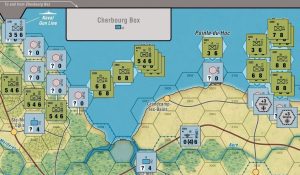
Also abstracted is the Cotentin peninsula and the city of Cherbourg. The map does not extend all the way up the north end of the peninsula. Instead, there is a series of exit row hexes marked with a “C” that link to the Cherbourg Box. Cherbourg was the only major port in the immediate vicinity of the Allied landings and its swift capture would allow the Allies to land more troops and supplies than could be landed directly onto the beachheads. Thus, the Allied player is incentivized to isolate and then capture Cherbourg as quickly as possible. The sooner this is accomplished, the greater the number of victory points awarded.
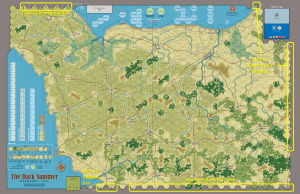
There is also a series of exit row hexes on the south and east map edges. Those marked with a “W” link to the Brittany Box, the peninsula west of Normandy, while those marked with an “E” lead to the Eastern Exit box. Historically, the U.S. was able to break into Brittany, drive down the west coast of France and then hook east and north to link up with the British who were driving south from Caen. The Allied player can try to recreate this encirclement by first exiting units into the Brittany Box. These units can re-enter on a subsequent turn through any of the hexes marked with an “S” along the southern edge of the map, assuming they’re not occupied by German units. Victory points are awarded for full divisions that can successfully enter the Eastern Exit Box.
Components
The Dark Summer components are typical of the high quality I’ve come to expect from GMT Games. The map sheet is clear, and the differing terrain is easy to discern. The half-inch counters are sufficiently thick, and the combat strengths and movement points are printed with large numbers, although older eyes may need reading glasses to see the other information (unit designation, setup hex, turn of entry, etc.) printed on the counters.
The game comes with three double-sided Player Aid cards printed on card stock. Two are identical, one for each player, and contain the Combat Results Table (CRT), Cherbourg Combat Table, Weather Effects on Movement and Combat, and Terrain Effects Chart. The third Player Aid includes tables for Replacements and Action Chits availability based on the current weather, Allied and German victory points, as well as the Sequence of Play and General Rule Reminders. The Player Aids are well organized and minimize the need to consult the rulebook during play.
The 24-page, full color, rulebook is printed on high quality glossy paper. It is organized efficiently and clearly written, with numerous illustrations and examples to assist players in learning the game. It is supplemented by a 20-page play book, most of which is dedicated to an extended example of play that covers the D-Day landings through action round 10 of the first turn. It also contains Ted Racier’s designer notes which I recommend players read to help put the rules in context.
Pacing
The Normandy campaign was a slow, attritional contest that lasted from the landings on June 6th to the closing of the Falaise pocket on August 21st. While the Allies had overwhelming superiority in troops and equipment, the Germans had the advantage of defending in advantageous terrain, notably the hedgerows and Caen. The Germans would hold out as long as they could before falling back to the next defensive position. The game recreates this, in part, by the action chits. Because the Allies cannot both move and attack on the same turn, unless they use one of their Combined Action markers, they will find themselves massing forces in preparation of an overwhelming attack, only to have the Germans retire a hex or two. Even with the Combined Action marker, the Allies’ movement allowance is restricted to one or two hexes and any subsequent attack suffers one column shift left on the CRT. Thus, a skillful German player can slow down the Allied defense while not giving up ground and casualties too rapidly.
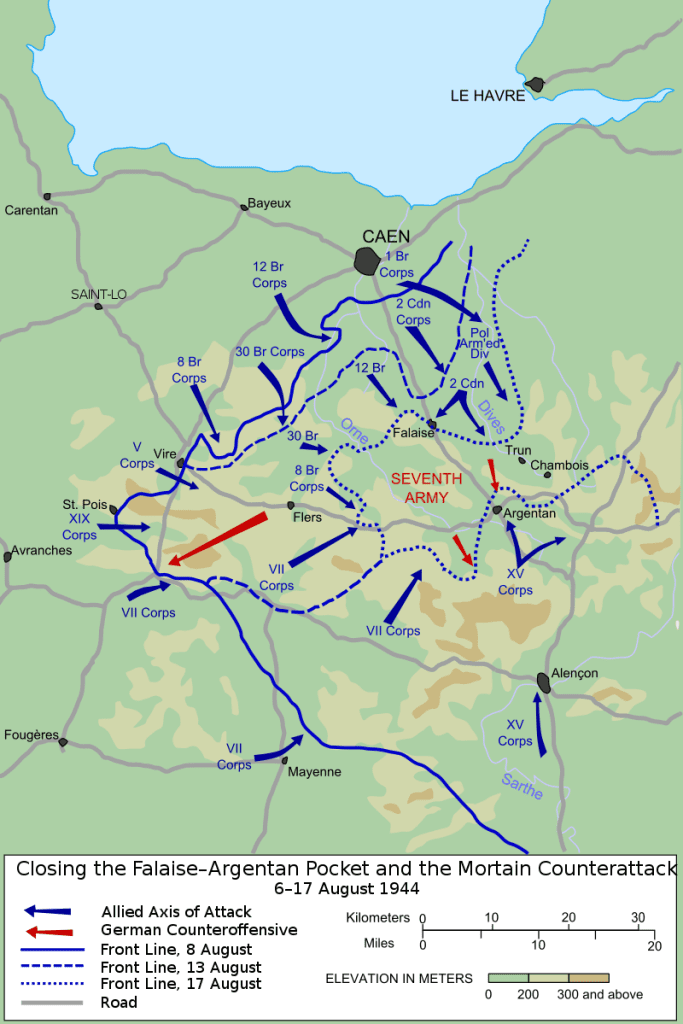
The only time the Allies will have an opportunity for some “open field running” is when the weather is Cloud or Sun. Not only do they have more action chits, they can use their airpower and their Prepared Offensive markers which provide one column shift right on the CRT for all attacks, to create a hole in the German line and exploit it by rushing forces through that hole. Most of the time, however, they will need to slog it out.
Despite the attritional nature of the campaign, the game itself moves swiftly. There are only 10 turns, with each turn being 10 to 12 action rounds, depending on the weather. This may seem like a lot, but each round goes quickly. And because it is not your typical “I GO, YOU GO” system, there is very little downtime between a player’s move. This keeps both players engaged, even when it is not their turn.
Balance
Yes, the Allied player definitely has the advantage in this game, as they did historically. The Allies will receive more replacements and reinforcements during the game, allowing them to keep up the pressure on the Germans even if it means taking more losses. When the weather is good, their air superiority will be devastating. Add in the Naval gunfire support near the beaches and the U.S. Tank Destroyer Support markers, and it is likely they will be able to achieve favorable combat odds somewhere along the front line.
Allied infantry divisions also have a distinct mobility advantage over their German counterparts. U.S. infantry divisions have a movement point allowance of 8, and British infantry divisions have an allowance of 10 points, reflecting the fact that most Allied divisions were motorized. Most German infantry divisions, on the other hand, have an allowance of 6 points to simulate they mostly traveled by foot or via horse drawn vehicles. This permits the Allied player to rapidly shift the point of their attack, as well as more rapidly exploit any breakthroughs. And while the German Panzer and Panzer Grenadier divisions are just as mobile, they cannot use the road movement rate on Sun and Cloud turns due to Allied air superiority.
Yet, that doesn’t mean the German player is bound to lose every game. The victory conditions present the Germans with two possibilities. First, they can win a sudden death victory by capturing an Allied Beach hex. This will be difficult because the Allied player will most likely ensure they have a continuous line of interlocking zones of control. But if there are any weak units in that line, the Germans could use their Panzer divisions en masse to break through to the coast. The other possible route to victory for the German player is to evacuate sufficient forces to the Eastern Exit Box, while preventing the Allies from doing the same. Of course, if the Germans do so in a way that allows the Allies to capture most of the map in the process, the Allies will gain a significant number of victory points.
As already noted, the terrain in Normandy favored the defender. Hedgerows, hills, forests, and marshes occupy most of the area, all of which provide one or two column shifts to the left on the CRT. The only open terrain is in the area around Caen. However, the Orne River, which bisects Caen, the marshes east of the Orne River, and hills south of Caen, all act to funnel Allied attacks into narrow corridors which the German player can hold with their Panzer divisions. Both the U.S. and British Commonwealth will need to come to grips with the Germans in difficult terrain.
The Mandatory Attack rule also gives the German player an advantage when defending. Two or more stacks can attack the same hex, but if there are other enemy units in the zone of control of the attacking units, they too must be attacked. That means some of the Allied offensive punch will have to be siphoned off on these diversionary attacks instead of the main assault, thereby lowering the overall combat odds ratio on the CRT.

Replayability
The Dark Summer contains elements that make each game play out somewhat differently. First are the German Strong Points and Ost Battalions (units composed of captured personnel from the Soviet Union – Ukrainians, Armenians, Azerbaijanis, etc.) which are randomly placed during setup. If some of the 2 or 3 strength point units occupy the beaches and other key points, it could slow down the Allied build-up, especially if they wind up on the Omaha beach hexes. This is exactly what happened in my first game, and it took several rounds to fully occupy and open the Omaha beaches. This and other factors made it so that I wasn’t able to make it down to Avranches and enter the Brittany Exit Box until Turn 9.
The randomness of the weather also affects how the game progresses. In my first game, the weather was either Storm, Rain, or Showers for the first five turns. This really slowed the Allied advance and allowed the German player to use the road movement rate while my airpower was grounded in England. In my next game, a Sun and Cloud marker came out shortly after the initial landings. This allowed me to quickly isolate and capture Cherbourg, and breakout west of St Lo using my U.S. Carpet Bombing marker. By turn 7, I had over a dozen U.S. divisions in the Brittany Exit box, and the British had exited 4 divisions off the east map edge.
Finally, there is the chit pull system. The Allies have the initiative every game turn, and thus always get to select one action chit from the cup of their choosing. But after that, it is a random draw. If the Allies cannot get several back-to-back action rounds, they will find the going quite slow, especially if the German player deftly uses their Reaction chits. Likewise, since the British do not have any Move/Action chits, they may find themselves drawing the wrong chit at the wrong time. Nothing can be more frustrating than to have moved up to the German player and then draw another Move chit rather than an Attack chit!
Summary
The Dark Summer is a deeply rewarding game that contains lots of interesting decision-making, but one that is not bogged down by a heavy rule set. The box says the game takes “4+” hours to play, while BoardGameGeek (BGG) says it takes 6 hours. Based on several playthroughs, 4 to 6 hours seems about the right range, which is not bad for a game that covers the entire Normandy campaign. BGG gives it a complexity rating of 2.91 out of 5 points, which puts it lower than several other games on the same topic I’ve played.
The game’s mechanics, especially the random factors, have a remarkable effect on game play, keeping each game fresh and filled with tension. As the Allied player, you always feel you’re on the cusp of that breakthrough that will collapse the German defense and send them into a headlong retreat. As the German player, you feel like the proverbial man holding on to the tiger’s tail. You know the situation is dangerous, but you dare not let go. You must hold on to key positions, but not so long that you run the risk of taking casualties you can ill afford to lose.
So, how does it compare to other Normandy games? Extremely well, in my opinion. It’s certainly not a “monster” game like The Longest Day (Avalon Hill, 1979) or The Battle for Normandy (GMT Games, 2009), and therefore much more likely to make it to my game table. In terms of playing time and complexity, it comes closest to Breakout: Normandy (Avalon Hill, 1992) and Normandy ’44 (GMT Games, 2010).
While I enjoy all of these, I prefer The Dark Summer. It best captures the attritional nature of the fighting that at any moment could shift into a fluid war of movement once an Allied breakthrough is achieved. And the variability from one play to the next keeps it coming back to my table. For those reasons, I can certainly find room on my gaming shelf for this additional Normandy campaign game.
___________________________________
- Some would argue that Ted Racier’s Case Yellow (GMT Games, 2011), which covers the German blitzkrieg into France, Belgium, and Holland, was the first game in the “Dark” series since it uses a very similar chit pull system.
- The Deadly Woods was published by Revolution Games when GMT Games opted not to publish it. As part of the deal, Revolution Games could not use “Dark” in the title.
- In many wargames such as The Dark Summer, a combat unit exerts a zone of control (or ZOC) into the six surrounding hexes, which reflects the unit’s ability to exert influence into those hexes through means of patrols, artillery observation, etc. For example, in most wargames, a unit must cease moving the instant it enters an enemy unit’s ZOC.







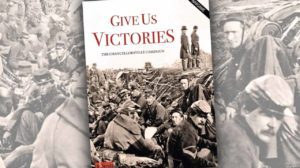




Add Comment